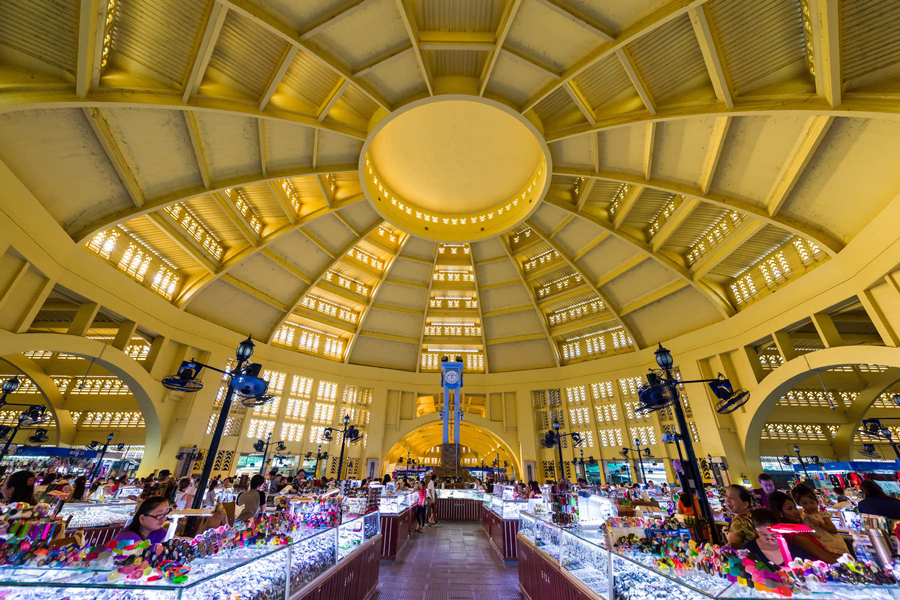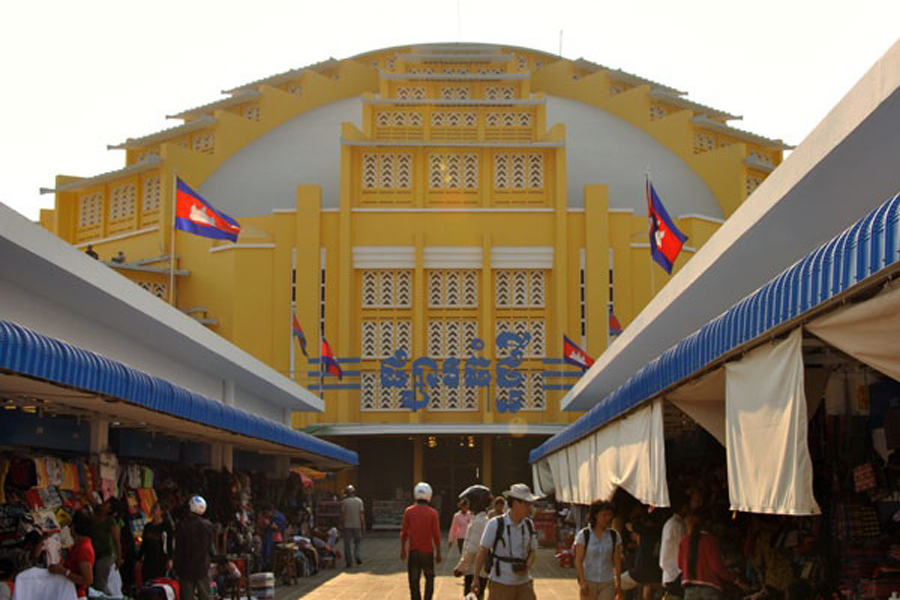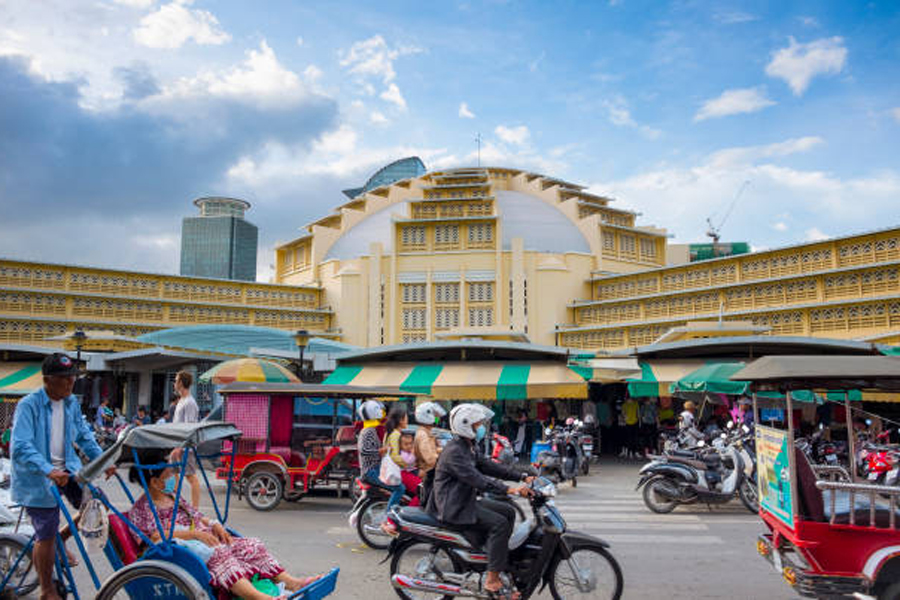Central Market

Central Market, also known as Phsar Thmei, stands as a vibrant testament to Cambodia's rich history and cultural heritage. Nestled in the heart of Phnom Penh, the market's iconic yellow-domed building, erected in 1937 during the French colonial era, draws visitors with its distinctive architecture. Divided into four wings, Central Market offers a captivating shopping experience, featuring an eclectic array of goods. From intricate jewelry and traditional textiles to modern electronics and fresh produce, the market caters to diverse tastes.

The bustling atmosphere is enhanced by the rhythmic hum of bargaining, creating a lively ambiance. Recent renovations have carefully preserved the market's historical charm while modernizing facilities, ensuring that Central Market remains a cherished landmark where locals and tourists alike can immerse themselves in the vibrant tapestry of Cambodian culture.
Central Market, stands as an enduring symbol of Cambodia's rich cultural tapestry and historical resilience. This bustling market, located in the heart of Phnom Penh, is housed within an architectural gem—a distinctive yellow-domed building that echoes the bygone era of French colonial influence, having been constructed in 1937. Its four wings intricately organize the market space, with each section dedicated to specific goods, creating a harmonious blend of tradition and modernity.

As visitors navigate the market's labyrinthine aisles, they encounter a sensory feast of offerings. The jewelry section showcases intricate Khmer designs alongside glittering gemstones, while the textiles wing unfolds a kaleidoscope of colors in traditional garments. Electronics enthusiasts can explore cutting-edge gadgets, and the aroma of fresh produce permeates the air in the market's food section. Central Market is not merely a shopping destination; it's a dynamic cultural crossroads where the past and present coalesce.
Bargaining is an integral part of the Central Market experience, as enthusiastic vendors engage with visitors in the age-old tradition of haggling. The lively atmosphere reverberates with the cadence of negotiations, creating an immersive experience for those seeking a genuine connection with Cambodian daily life.
.jpg)
In recent years, Central Market has undergone careful renovations to preserve its historical significance while enhancing the overall infrastructure. These efforts ensure that the market remains a beacon of authenticity in Phnom Penh, offering both locals and tourists a glimpse into Cambodia's storied past and its vibrant present. Beyond its role as a marketplace, Central Market stands as a testament to the resilience and adaptability of Cambodia's cultural heritage, inviting all who visit to become a part of its living history.
You may also like:
Central Market, Phsar Thmei, stands as an enduring emblem of Cambodia's historical resilience, tracing its roots back to the colonial era when it was officially inaugurated in 1937. Conceived under the architectural vision of Louis Chauchon during French rule, the market's Art Deco design was a departure from conventional marketplaces, featuring a distinctive central dome and four wings, symbolizing the four petals of the lotus flower. Throughout Cambodia's tumultuous history, Central Market weathered the storm of the Khmer Rouge regime in the 1970s and the subsequent civil unrest, embodying the tenacity of the Cambodian people. Post-conflict, as Cambodia sought stability and reconstruction, the market underwent renovations to both preserve its architectural heritage and adapt to modern needs.
The market's journey reflects the economic and cultural evolution of Phnom Penh, shaping itself as a vital economic hub through changing times. In recent years, Central Market has emerged not only as a commercial center but also as a cultural landmark, drawing tourists and locals alike with its unique blend of historical charm and contemporary vibrancy. The market's architecture, with its bright yellow facade and bustling interior, is not just a physical space but a living testament to Cambodia's capacity to endure challenges and preserve its identity. Today, Central Market stands at the intersection of tradition and modernity, symbolizing the dynamic spirit of a nation that has embraced its past while stepping confidently into the future. As a bustling marketplace and cultural icon, Central Market continues to be a focal point, inviting all who visit to explore its rich history and partake in the vibrant energy of Phnom Penh.

1. Morning Hours: As mentioned earlier, the market is generally liveliest in the morning. Arriving early allows you to explore the market when it's less crowded, and the weather is relatively cooler.
2. Weekdays: Weekdays are usually less crowded compared to weekends. If you prefer a quieter experience and want more time to explore without large crowds, consider visiting on a weekday.
3. Avoid Midday Heat: Cambodia can get quite hot during the midday hours. If possible, try to avoid the peak heat by visiting in the early morning or late afternoon. This can make your market experience more comfortable.
4. Explore the Surrounding Area: The Central Market is located in a vibrant area of Phnom Penh. After exploring the market, you can also check out nearby attractions like the nearby streets with various shops, restaurants, and historical sites.
Getting to the Central Market (Psar Thmei) in Phnom Penh can be done through various means of transportation. Here are some options:
1. Tuk-Tuk:
- Tuk-tuks are a popular and convenient mode of transportation in Phnom Penh. You can easily find tuk-tuks throughout the city, and many drivers will be familiar with the location of the Central Market.
- Negotiate the fare with the tuk-tuk driver before starting your journey.
2. Taxi:
- Taxis are available in Phnom Penh and can take you directly to the Central Market. You can hail a taxi on the street or ask your accommodation to arrange one for you.
- Ensure that the taxi driver uses the meter, or agree on a fare before starting your journey.
3. Motodop (Motorbike Taxi):
- If you're comfortable riding on a motorbike, you can use a motodop service to get to the Central Market. Negotiate the fare before starting your ride.
4. Walking:
- If you're staying in the central part of Phnom Penh, you might find that walking to the Central Market is a viable option. It allows you to explore the surroundings and take in the local atmosphere.
5. Cyclo:
- Cyclos are three-wheeled bicycle taxis that can be a slower but more scenic way to travel short distances. You can find cyclos near popular tourist areas.
Remember to write down the name and/or address of the Central Market in Khmer (local language) or display the name and/or address on the map for your chosen mode of transportation. This can help ensure better communication, especially if there is a language barrier. Also, always agree on a fare or confirm meter usage before starting your journey. If you have any questions about the itinerary, please contact Asia King Travel immediately.
You may also like: